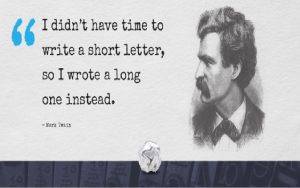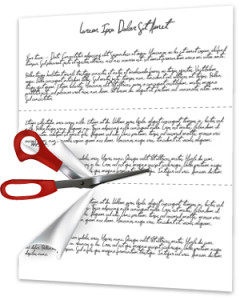Lately, I was asked to reduce a paper by 20% to meet the word-count requirements of the target journal. As you might except, this can be a painful task, because you don’t want to lose the body of your writing, but you’ve got no choice if you want to hand the piece in as required. Furthermore, this can be even more painful if you are not native English speaker. To me, the paper was already quite short as a literature review study, but nothing to do! Thus, I decided to consider the ways I could shorten the paper, and as a researcher I strated doing some research on it! Then I found out that I was not the only one ! 🙂 I have read a lot of ways, techniques and to do lists for shortening the academic articles.
In today’s blog post, I would like to share some of the techniques and example to shorten a paper without eliminating anything important with you.
1. Firstly, check the following that might let you reduce the word count without doing any modifications: a) Do the references count? b) Does the appendix count? c) Does the abstract count?
2. Delete, delete, delete …
When you remove some words from any sentence and still it does not change the main idea so definitely remove those words. It may seem difficult at first, but after deleting some words back and read the piece once more, I guarantee that you will see that you have deleted much more words than you guessed.
 a. Delete articles, adverbs, adjectives, connectives, propositions, and auxiliary verbs
a. Delete articles, adverbs, adjectives, connectives, propositions, and auxiliary verbs
Occasionally articles are essential to make something specifically clear. Though, often, they’re just fillers and can safely be eliminated if their presence isn’t necessary for clarification. Let’s look at this example,
With articles: He won second place for the best tasting pie, as well as third place for the most original ingredients.
Without articles: He won second place for best tasting pie, as well as third place for most original ingredients.
Adverbs are usually very deletable in academic writing. For example, “dropped rapidly” could be replaced with “plummeted”. Tip ! using ctrl + f to search for “ly” is a quick way to find a lot of adverbs. As an alternative of using adjectives, try to keep your prose clear and straightforward, and get straight to the point. Avoid detailed descriptions unless they are absolutely necessary for following your argument and you are sure that the reader needs the detail. Rather than having longer sentences linked with “and” or “but”, just delete those connectives and have two separate sentences. This will reduce the word count.
Remember ! Keeping everything clear and simple will make this process easier for reader.
Convert chunks of text that use a lot of unnecessary prepositions into rephrased, shorter versions without prepositions: you could replace “functions of technology” with “technology function” . The auxiliary verbs you might want to remove in academic writing are ones like “could”, “may”, “might” and so on.
Do ! Say what you mean directly and drop the extra verbs wherever you can.
b. Eliminating unnecessary spaces
Extra spaces between words, numbers and the percentage sign (%), the degree sign (°), symbols or operators and within numerical ranges and fractions can lead to word count inflation. Example: 55 % → 55% (-1 word)
c. Eliminating wordy transitions
In addition → Additionally, Moreover, Furthermore
In particular, More specifically → Specifically
As a result ,As a consequence → Thus, Therefore, Consequently
On the other hand →Instead, Conversely, Alternatively
3. Cut out repetitive chapter-linking sections
In academic writing, a lot of people have a habit to ‘tie off’ each section with a mini-summary and then ‘refresh’ the reader again in the beginning of the next one. This is redundant and wastes a lot of word count.
 4. Two-line rule !
4. Two-line rule !
Do not extend sentence if you are not a native English speaker like me! The reader can’t remember how the sentence began upon reaching end if sentence is too long. Here is simple rule; don’t let sentence exceed two lines, otherwise split it. We love to use connectives so it would be end up being a very long sentence. Combined sentences turn into twisted just like caterpillars.
5. Write using active voice instead of passive voice
Active voice also typically requires fewer words to convey your ideas.
Passive voice: It was found that protein X activated transcription of gene Y. (11 words)
Active voice: Protein X activated transcription of gene Y. (7 words)
6. Reduce the introduction and conclusion
Two of the important parts of academic papers are the introduction and conclusion as their main function is to summarise the whole work. There’s no need to go into a lot of detail in these sections, that’s what the main body is for. Also remember that you should not include new information in the conclusion, keep it all in the main body.
7. Don’t rewrite data that is already presented in your tables and/or figures
It is acceptable, and typically preferred, to simply refer to your table or figure in the text instead of repeating data in the text that is also presented in either a table or figure. For example, you can simply state “Teacher demographics are described in Table 1.”
8. Review your chapters carefully to remove info or data that is defined in earlier
After you have finished writing your manuscript, go through the entire text again to see if you have repeated any information in more than one section. For example, you may describe your data in the Results section and again in the Discussion. If you find this type of redundant text, it is fine to simply refer back to the original section in which the information or data is discussed. While eliminating this type of redundancy, you should be careful not to eliminate any important points, but, believe me; this helps you to reduce your word count.
9. Avoid starting sentence with “there are” or “there is.”
The phrases “there are” or “there is” are typically unnecessary and can be eliminated entirely. For example: There are no previous studies investigating the relationship between classroom management and student profile. This can be rewritten eliminating “there are” as following. No studies have investigated the relationship between classroom management and student profile.
10. Keep the mode !
Love the tenses. Yes, the study carried out in the past, nevertheless, in the article, when you describe the study using present tense seems more accurate. In fact, this issue is open to debate! But at least we can agree on ending a paragraph with the same tense as you started.
To sum up, there are plenty of sources for those who want to find out how to write an academic article in English language. For example, James R. Wilson’s article is the good one to start. Especially, the references at the end offer a nice selection for good academic writing, among all of the references, I definitely recommend The Elements of Style ( EOS ) !
Useful Resources
http://www.biosciencewriters.com/
http://www.editage.com/insights/10-tips-to-reduce-the-length-of-your-research-paper
http://www.wikihow.com/Avoid-Going-Over-an-Essay-Word-Limit
http://kurucz.ca/research/reducing.php


Recent Comments